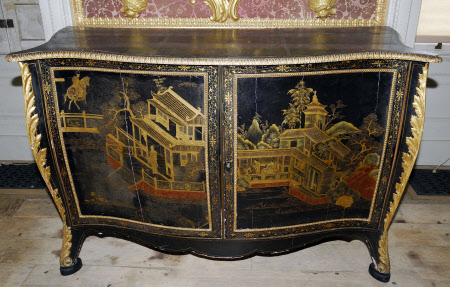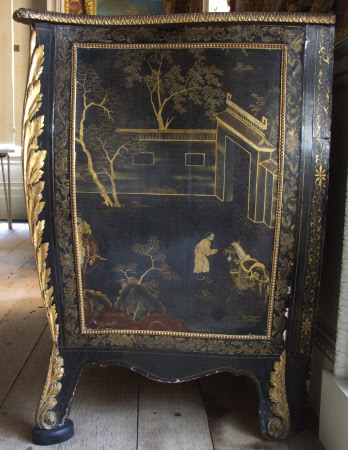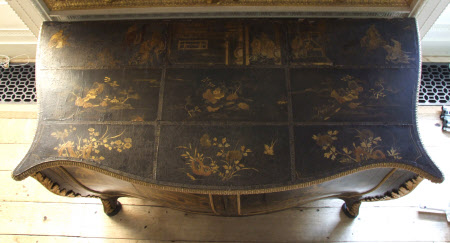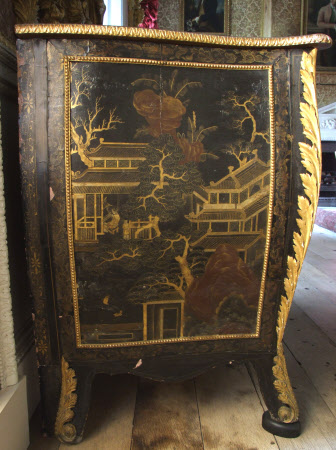Commode
attributed to Pierre Eloy Langlois (1738 - 1805)
Category
Furniture
Date
circa 1765
Materials
Pine, tropical hardwood, veneered with Chinese lacquer, japanned borders, giltwood and ormolu mounts
Measurements
90 x 146 x 65.5 cm
Place of origin
London
Order this imageCollection
Uppark House and Garden, West Sussex
NT 137649.1
Summary
A lacquer commode, from a pair, circa 1765, attributed to Pierre Langlois (fl.1759-1781), veneered with panels of Chinese export black, gold and red lacquer, bordered with japanned foliate trails, with a serpentine shaped top divided into nine panels, within a giltwood carved border, above a pair of doors enclosing a single shelf. The bombé front and sides veneered with lacquer panels with carved beaded borders and depicting scenes of palace life with figures in gardens and on terraces, the angles mounted with giltwood full-length acanthus leaves, the four feet with gilt bronze foliate scrolls. Lacquer screens and cabinets were introduced by the East India Trading Companies in the late 17th Century but the technique of applying lacquer panels onto a serpentine shaped commode seems to have been introduced to London in the early 1760s and is related to Pierre Langlois' work, cabinet-maker reputably of French origin and established on Tottenham Court Road. Although a large proportion of Langlois' production is associated with marquetry, a few Chinese lacquer commodes are attributed to him. A pair of similar commodes with a comparable top divided into sections are thought ti have been commissioned by Francis Seymour, 1st Marquess of Hertford (1718-1794) for Ragley Hall (illustrated in The Dictionary of English Furniture, fig.13). Another comparable commode, from a pair, can be seen in the Legion of Honor museum (San Francisco) and was commissioned from Langlois by Horace Walpole (1717-1797) for the Gallery at Strawberry Hill House. Almost identical to the latter, with a marble top and ormolu mounts, are the pair of commodes at Powis Castle (NT 1181049.1-2). In comparison, the Uppark commodes gilded mounts are partly executed in carved wood which is a rarity and a commode in the Lady Lever Art Gallery shares this characteristic. Originally two pairs of commodes stood at Uppark. One pair was offered at Christie’s 20 May 1971 (lot 90). There are a few small differences between the two pairs, notably the form of the giltwood mounts to the angles.
Provenance
Commodes presumably commissioned by Sir Matthew Fetherstonhaugh (1714-1774) for Uppark; by descent; given to the National Trust in 1954 with the house and some of its contents by Admiral the Hon. Sir Herbert Meade-Fetherstonhaugh.
Makers and roles
attributed to Pierre Eloy Langlois (1738 - 1805), maker
References
Macquoid, Percy, The dictionary of English furniture :, 1983 Wood, 1994: Lucy Wood, The Lady Lever Art Gallery, Catalogue of Commodes, London, 1994



